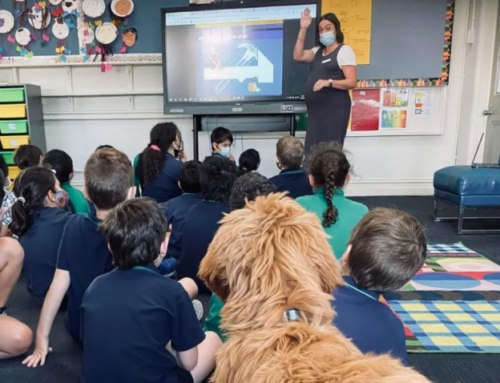Benefits of a Dog in the Classroom
The presence of a dog in the classroom has wide-ranging benefits that can improve the learning environment for students and teachers alike. Studies have shown that students may have improved academic performance, better social skills, and greater self-esteem due to regular interaction with a canine companion. Additionally, research indicates that dogs can help to reduce anxiety, increase comfort within educational settings, and generate positive emotions between students and instructors.
Our experience has shown that a dog’s presence in a classroom can make it easier for children to engage in cooperative learning, express their need for physical contact or affection, and cope with stress. Such qualities can help to create an environment conducive to communication between all students in class. Furthermore, having a constant companion in the classroom can lead to stronger bonds among classmates and foster respect as well as trust for each other.
Naturally, there are times when parents and students have concerns about the potential hazards that could arise if there is an unruly dog disrupting class or an inability to guarantee safety from infections or allergies. To address these issues, schools that invite dogs into their classrooms should always have procedures and guidelines in place along with appropriate staff training so the rights of individuals with allergies or fear can be respected and avoid incidents like scratches or bites. This is where our team at Dogs Connect comes in to provide the information, training, and integration required for a dog to be at home with the school community.
- A study conducted by the University of Missouri found that the presence of a therapy animal in the classroom was associated with improved student engagement and behavior.
- In a 2018 study, 84% of teachers reported that students had increased feelings of empathy towards animals or other people when interacting with a therapy animal in the classroom.
- Research from 2019 showed that students who interacted with therapy animals in the classroom demonstrated significant reduction in stress levels in comparison to those without such an opportunity.
Improved Student Learning
As indicated by the above statistics, the introduction of dogs into the classroom has been linked to improved student learning. Research shows that when students are exposed to animals, their readiness to learn increases, their focus improves, and they become more engaged in the lesson. A study done by Indiana University found that college students taking a course that allowed them to bring their own dogs performed better than students without dogs.
Introducing canine companions into classrooms also stimulates a sense of connectedness among students and teaches them responsibility. Educators note that having a dog around triggers a socially interactive environment, which helps non-verbal students open up more easily and speak about their concerns or worries. The presence of dogs can also encourage an atmosphere of support and comfort for both educators and students, underlining the importance of respect and empathy in educational settings. At Dogs Connect we have many case studies available from the many schools we run programs with and you can watch these here to check out what teachers and students say about how our integrated services have worked for them.
Animals have proven to be a powerful source of comfort for those struggling with various mental health issues like depression or anxiety. Thus, it comes as no surprise that some schools are beginning to look at the value of animal-assisted interventions as part of a student’s treatment plan.
Though there are some cautions to consider when placing pets in the classroom learning environment, there is still plenty of evidence suggesting that this type of intervention can improve student learning significantly. With proper care and caution taken into consideration, animals can provide invaluable guidance and support for learning within academic settings. As new studies come out examining the subject further, we may very well see animal-assisted therapies become mainstream elements in schools worldwide.
Greater Social Interaction
One of the most notable advantages of having dogs in the classroom is an increase in social interaction. The presence of a dog can provide children with an outlet to express their emotions and interact with other students on an emotional level. Studies have shown that when students interact with animals, their ability to self-regulate their own emotions increases, leading to better relationships and teamwork. Additionally, kids who struggle with socialization may feel more comfortable interacting with a pet than they would another person. Dogs Connect have years of experience in integration of dogs within school settings such as primary schools and working with teachers on site.
Advantages of Caring for Dogs
Then there is the task of caring for a pet, specifically, a dog offers several advantages and emotional benefits that can be extremely beneficial both to young students and educators alike. While caring for an animal may seem intimidating at first, research indicates that these tasks can improve student self-esteem and responsibility, help regulate their emotions, and acknowledge their unique abilities.
Including a dog in a classroom setting has been proven to provide symptoms of loneliness and stress relief to those children who have difficulty making connections with peers due to “insecurity, shyness, bullying or disability”. Furthermore, being able to form an emotional bond between student and teacher is a major advantage when it comes to initiating learning processes. Studies show that “those introducing pets into classrooms often observe an increase in self-confidence: students are willing to take risks in front of their peers if their pet is present”. This was especially seen when introducing dogs as it seemed teachers and students alike reported feeling calmer in the presence of the animal.
On the other hand, some may argue that this kind of responsibility falls outside of the role of an educator, or there may be certain implications such as allergies within the classroom. It is important to note, however, that these potential issues are more than manageable with a framework of good practices developed by experts—like “frequent cleaning and separation from contact areas”. Therefore, dogs can still offer a safe space for kids without causing disruption or medical concerns.
With all factors considered, caring for a pet allows us to embrace the full range of benefits associated with its presence. Areas like improved attention and focus are only a small part of what may occur when interacting with animals in the classroom. It is thus necessary for school administrators to recognize opportunities where dogs can make a significant difference in the lives of our youngest learners – ones that will likely lead to Improved Attention & Focus as discussed in the following section.
Improved Attention & Focus
Having dogs in the classroom has long been believed to increase focus, and attention and keep students engaged. Studies show that having a pet in the classroom can improve focus and concentration on academic tasks and provide general emotional support for the students. Dogs in the classroom have also been demonstrated to help reduce disruptive behaviors, such as talking, moving around and fidgeting, which can boost overall student engagement.
Overall, having pets in the classroom seems to have a positive impact on children’s focus and attention. From reduced disruptive behaviors to increased task engagement and motivation levels, there are many components of learning that are positively impacted by pet presence. While there are widely known dog therapy programs out there, Dogs Connect provides something unique with their Well Being Dogs programs helping students overcome barriers and giving educators further tools they can have in their kit to create a positive and enhanced learning environment.
The Dog’s Role in Creating a Calming Environment
Having a dog in the classroom may be a useful tool for creating a calming and relaxing environment, which further promotes learning. While there are some detractors to this notion, such as potential allergies or messes that the dog may leave, proponents of this method suggest that its benefits far outweigh any potential drawbacks.
Proponents of bringing dogs into the classroom point out that having a canine companion can help ease anxiety and reduce stress for students by providing emotional support and comfort. Having a pet nearby can be an effective way to provide students with an emotional boost. Research has shown that petting an animal can decrease levels of cortisol, the hormone responsible for stress, in humans. Dogs bring a comforting presence and unconditional acceptance, making students feel safe and secure.
In addition, dogs provide companionship and offer positive social interactions between students who struggle to find friends in traditional classroom settings. This bond fosters development that is often difficult to achieve through other educational activities because it relies more on feeling than intellect. Furthermore, incorporating animals into educational practices teaches children to learn respect towards animals and encourages emotional maturity and understanding.
Despite these potential drawbacks, having a dog in class can help create an atmosphere of calmness and acceptance within which students can excel academically and socially. When appropriately managed and regulated, having dogs in classrooms offers significant therapeutic benefits for both teachers and students alike. To move forward successfully in unlocking these benefits of having pets in the classroom education system, it is essential to look further at the other therapeutic effects of including animals in learning spaces.
Other Therapeutic Benefits of Pets in Education
The presence of pets in educational settings can have a wide range of positive benefits, especially for students experiencing stress or emotional difficulty. Pets can provide therapeutic support and can help increase feelings of comfort and motivation in students.
For instance, animals can act as a form of emotional support for students who may be struggling with social interactions or self-confidence issues. Having an animal present can provide a sense of safety, allowing students to open up more easily when discussing their problems or communicating with others. Studies have also found that pet contact not only increases levels of oxytocin (a hormone associated with trust) but also reduces cortisol levels (a hormone associated with stress). This can lead to improved emotional well-being for those who struggle to feel secure in unfamiliar environments. Furthermore, spending time with animals can release endorphins, resulting in reduced anxiety.
In addition to providing emotional support, having a pet in the classroom can also activate student interest and improve the discussion. For example, having a dog nearby often encourages more creative conversations as children engage directly with the animal while sharing ideas. Moreover, research suggests that physical contact with animals — such as petting dogs — improves student focus and decreases restlessness during lectures, leading to more engaged pupils within the classroom environment.
Time To Start Thinking Differently
With the advent of social media, technology, and gaming is it time to consider the benefits that a dog brings in terms of encouraging physical activity and getting students moving. Teaching strategies may have evolved but the needs of a child seem in some ways more complex than ever. The ability of a dog to provide assistance in getting better classroom outcomes and improving the wellbeing of a community of students is a powerful gamechanger. If you would like to learn more about how Dogs Connect can help you please get in touch with us by clicking here.











